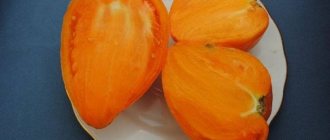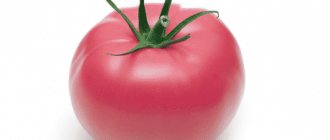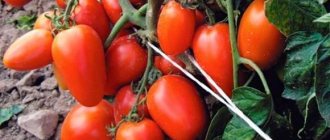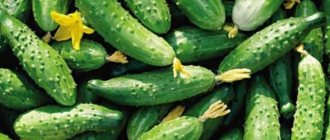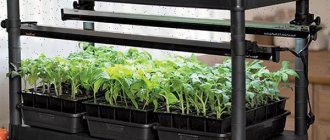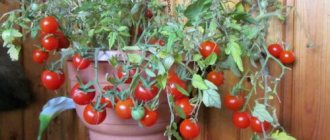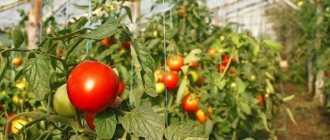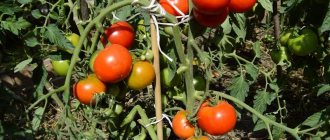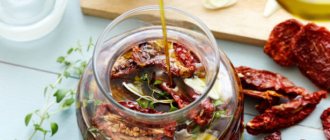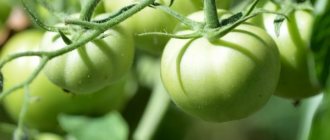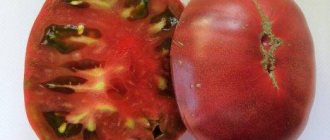Cherry tomato bushes Golden Flow F1 are completely covered with dense oval golden-colored tomatoes hanging in beautiful tassels. Due to the shape and color of the fruit, it seems that golden streams are flowing down from the top of the plant - hence the name of the variety.
| Height | Landing location | Ripening time | Fruit color | Fruit size | Origin | Fruit shape |
| Tall | Greenhouse | Early ripening | Yellow | Small | Hybrid | Round |
Content
- Growing the Golden Stream is a very easy task without profit. You need to constantly watch the tomatoes, harvest and process them. The fact that the bushes do not need to be pinched makes it very easy to grow. It’s also good that there is no need to monitor growth, since, having collected the required number of ovaries, the bush stops growing.
- Due to their short stature, the bushes do not take up space and are good to grow in small greenhouses. Even otherwise, there are intentions to plant tomatoes in the garden in an open bottom, all the same - first you need to keep them warm.
- In the interest of better ventilation of the ground, you should tear off the leaves on the lower part of the stem.
- Take small bushes, but it is better to tie them up so that they fall unprofitably from a large number of fruits, and on open ground - from unfavorable weather conditions.
Soil preparation
Golden Stream produces the highest yields on light loamy and sandy loam soils, as well as on non-flooded areas of the floodplain. You can plant tomatoes in places where cucumbers, legumes, corn and cabbage were previously grown.
If fresh manure was already added to the previous predecessors, then when digging and preparing tomato beds you need to add superphosphate and potassium chloride, and then do a deep dig.
In spring the soil is harrowed. Another portion of fertilizer is placed in the furrows or holes - compost soil, garden mixture or ash.
Characteristics of tomato
Characteristics of the tomato variety Marusi:
- compact, strong bushes;
- high-yielding;
- drought-resistant;
- fruits with a long shelf life;
- resistant to temperature changes;
- average resistance to late blight and other fungal and viral diseases (verticillium and fusarium);
- taste – rich, sweet and sour;
- contains a large amount of dry matter.
The Marusya tomato is a frequent guest on store shelves due to the good keeping quality of the fruit and the long shelf life of its product characteristics.
Productivity and fruiting
Thanks to its quality characteristics, from 1 sq. m. you can collect from 6 to 8 kg of ripe fruits. To increase productivity, pinching is carried out, which allows you to remove up to 2 kg of fruit from one bush.
The Marusya tomato variety was bred for cultivation in open ground and greenhouses. In the southern regions, ripening occurs in mid-July. In the Western and Northern regions - the end of July. Fruiting lasts about one month.
Area of application of fruits
The Marusya tomato is used for preparing salads, tomato paste, canning in its entirety, and making tomato juice. They are consumed fresh and cooked along with other ingredients (baked, fried, boiled).
Resistance to diseases and pests
During testing of the characteristics of the variety, it was revealed and described that the Marusya tomato tolerates temperature changes well, and even during prolonged rains and bad weather conditions it is rarely affected by viruses and fungi.
Verticillium wilt can spread quickly throughout the entire bush, starting with the lower leaves that turn yellow and wilt. Tomato showed high immunity to this disease, as well as to fusarium.
The variety has average immunity to late blight (brown rot).
The fruits and bushes of Marusya are rarely attacked by spider mites and slugs, only with strong constant humidity. This problem can be easily dealt with by laying a layer of sand, sawdust around and making drainage grooves.
Advantages and disadvantages of the variety
Advantages of planting and growing the Marusi tomato variety:
- the fruits do not crack or fall off;
- does not deteriorate during transportation;
- has a high-quality, beautiful presentation;
- fruits with a long shelf life;
- tomatoes are suitable for pickling and canning; the skin does not crack when poured with boiling water;
- the variety is resistant to temperature changes and diseases;
- has a rich tomato taste and strong aroma.
The disadvantages of the cultivated variety include:
- the need for garters due to heavy hands, but not always;
- short period of fruiting, yields the entire harvest by the end of summer;
- you need to plant the seeds up to the first cluster, then the yield increases.
Sweet varieties of yellow tomatoes
Honey saved
The plant is of an indeterminate type; the fruits ripen quickly in greenhouse conditions and a little later in an open area. 110-115 days after the moment when the seeds sprouted, you can enjoy the first fruits. In the garden, bushes of this variety grow up to 1.2 m in length, in greenhouses - up to 1.7 m.
This variety of yellow tomatoes is most resistant to such a common disease among nightshade crops as fusarium. The yellow-honey heart-shaped fruits can be quite large in size - almost 1000 g.
Honey Spas tomatoes have a sweet taste, but with a barely noticeable sourness. One bush produces a fruit harvest with a total weight of 4-5 kg. These yellow tomatoes are best suited for making fresh salads, juices, and snacks. The variety is not intended for conservation. Vegetables can be stored for a short time under certain conditions.
Caramel yellow
Refers to early ripening varieties capable of producing large yields. The plant is indeterminate and grows up to 2 m in height. Up to 50 tomatoes are formed on massive clusters. From an area of 1 square meter you can collect about 4 kg of ripe fruits.
Yellow caramel bears fruit throughout the season. The pulp of tomatoes is fleshy, of medium consistency, and the taste is sweet. The fruits are small in size, weighing 30-40 g, which is very convenient for canning. They are also used for making salads, juices and for various preparations for the winter. Thanks to the strong skin of the fruit, they can be perfectly stored for a long time.
Zebra
This unusual exotic variety of tomatoes is endowed with a unique taste. In addition, it has a unique color: yellow with orange stripes along it. The pulp inside the fruit has pink spots.
The indeterminate bushes of this crop grow up to 180 cm and require additional support. The fruits are round in shape, slightly flattened with a ribbed surface and weigh up to 300 g. They taste sweet and juicy.
Yellow target
Tomatoes of this variety have a very pleasant taste: sweet with the aroma of peaches. The fruits are spherical in shape and yellow in color. A characteristic feature of the variety is a pink spot located on the surface of the vegetable.
Yellow giant
Gardeners also call it the Yellow Giant. The tomato received this name due to its large size. The weight of the yellow vegetable can reach up to 300 g. The variety is valued for its excellent taste. In addition, the plant bears fruit all summer until the coldest weather. The plant is an indeterminate variety and can grow above 1.8 m in height. It requires mandatory gartering and pruning of the stepsons.
Mid-season, after the appearance of the first sprouts, after 110-122 days you can harvest flat-round fruits. The Yellow Giant tomato variety is most suitable for cultivation in the regions of the central zone of the country. Tomatoes are very sweet and have a special aroma. They do not crack during storage and transportation.
Orange
The yellow tomato variety lives up to its name. It is very similar in shape and color to a citrus fruit. In addition, the fruits have a wonderful taste. Eaten fresh. Tomatoes are recommended for children's and dietary nutrition.
Advantages of the variety:
- high productivity;
- immunity to disease;
- perfectly stored;
- does not deteriorate during transportation;
- withstands temperature changes;
- all fruits grow the same size;
- The purpose of the variety is universal.
Golden Stream is a determinate variety. This means that the plant has limited growth, that is, after tying 5-7 clusters, the bush stops growing and devotes all its energy to the formation of fruits. This variety grows no more than 70 centimeters in height. This circumstance is considered a good advantage over varieties that do not stop growing. Firstly, the Golden Stream gives a very early and friendly harvest. Secondly, you don’t need to spend a lot of time forming bushes and additional garters. Thirdly, the harvest ripens at the same time.
There are not very many leaves on the bush. The foliage is dark green, slightly rough. One branch (brush) produces an average of 8 fruits.
The fruits of the variety are oval-shaped, small in size, weighing 70-80 grams. The color of tomatoes is yellow-orange or golden yellow. The crust is thick. Does not crack when ripe.
The pulp is dense, juicy, there are few seeds. Sugar content – 4.5%. There is an excellent sweetish taste. The variety is excellent for preservation.
The undoubted advantage of the Golden Stream is its high productivity. From one square meter it is possible to collect up to 10 kilograms of quality tomatoes (up to 35 tons per hectare). Due to its attractive appearance, good shelf life and tolerance to physical influences, the variety is grown on an industrial scale for sale.
Golden Stream has strong immunity to all known tomato diseases.
The only scourge is the Colorado potato beetle, which must be combated with the help of biological agents. Important : due to the fact that the Golden Stream variety is an early-ripening, low-growing variety, the plants simply do not have time to get late blight.
How to harvest?
The first golden fruits can be seen already in early July. At the height of summer, small tomatoes will hang on each bunch. The variety does not produce fruits for long, which makes it easier to harvest and prepare for the winter.
But the time for the formation and ripening of tomatoes can be extended by picking them technically ripe. Then the bush will be freed from excess load and will be able to bear fruit again.
Many people believe that unripe tomatoes are of worse quality than those ripened in the garden. But that's not true. Green fruits quickly acquire a marketable appearance in the sun without losing their taste. They store well, just like vegetables picked when ripe.
By the end of summer, as temperatures drop, tomato bushes die off. You need to monitor this moment in order to harvest the entire crop and prevent some tomatoes from spoiling.
Reviews
Ekaterina, Moscow region:
“I learned about the Golden Stream from my neighbor in the country. I sowed it and got two in one: delicious tomatoes and a decorative look for the plot. I recommend this unpretentious and high-yielding variety to everyone.”
Elena, Leningrad region:
“I read reviews about Golden Stream tomatoes and decided to grow them in open beds through seedlings. I didn’t expect a rich harvest in our climate, but the tomato turned out to be resistant to the changeable St. Petersburg weather and gave us a generous harvest by the end of summer. Next year I will definitely plant this miracle.”
The description and characteristics of the variety speak for themselves. With proper care, the yield is 4 kg per square meter.
Harvests of beautiful juicy cherry tomatoes - Golden Flow F1 tomato: variety description and growing tips
Cherry tomato bushes Golden Flow F1 are completely covered with dense oval golden-colored tomatoes hanging in beautiful tassels. Due to the shape and color of the fruit, it seems that golden streams are flowing down from the top of the plant - hence the name of the variety.
| Height | Landing location | Ripening time | Fruit color | Fruit size | Origin | Fruit shape |
| Tall | Greenhouse | Early ripening | Yellow | Small | Hybrid | Round |
Description and characteristics of the variety
The variety is early ripening, requiring 110-112 days to ripen. The fruits are medium-sized - maximum weight 50 g. From 9 to 13 tomatoes ripen on a bunch.
Hybrid Golden Stream - modern, small-fruited, cluster type. The brushes are extremely beautiful and dense. The tomatoes on the branch ripen at the same time. All fruits are aligned, of the same size and shape. Unripe tomatoes are light green, mature tomatoes are yellow. The tomatoes are dense, have a good taste, and their main purpose is as a salad.
The hybrid was bred by Agro (Moscow region), included in the register in 2015, and allowed for cultivation in all regions. Golden Stream is recommended for cultivation under film covers in amateur vegetable growing.
Advantages and disadvantages
- dense, crack-resistant tomatoes;
- concentrated and rich taste;
- graceful shape of the fruit;
- first generation hybrid, resistant to diseases and unfavorable climatic conditions;
- sets fruit perfectly even in stressful heat conditions;
- manages to ripen on the branches in August even before the first cold snap;
- looks good in small containers;
- looks beautiful in glass jars for whole-fruit canning.
Minuses:
- Suitable for greenhouses only;
- requires formation;
- unsuitable for processing.
Productivity
In a greenhouse you get 6 kg per square meter. 2 kg are collected from a bush. With proper care, productivity is slightly higher. The crop can be harvested with whole clusters.
Features of cultivation and storage
The hybrid is grown through seedlings. An early harvest is produced by strong, stocky, not elongated bushes - they have many well-developed flower primordia even at the seedling stage. Therefore, seedlings need good lighting. It is better not to sow seeds early, when daylight hours are still short. The optimal sowing time is mid-March. The seedlings are transferred to the greenhouse already picked into cups and replanted with a lump of earth.
Planting and care
The planting pattern is 70 by 70 cm. The vines are formed into one shoot, avoiding thickening. They take stepsons every week. At the end of July, the tops of the plants and the lowest leaves are removed.
Beneficially increase the yield of fruits per unit area of fertilizing. The first is carried out 2 weeks after planting the seedlings, dissolving a tablespoon of urea in 10 liters of water. Then fertilizing is done with complex fertilizers: azophosphate, nitrophoska. You need to fertilize once every 10 days until the fruits set.
Features of cultivation
Summer residents never have problems growing tomatoes of this variety. The seeds generally germinate without exception, and the yield is 97-100 percent. The variety tolerates short-term unfavorable climatic conditions well. However, since the low-growing Golden Stream really needs constant warmth, it is recommended to plant it in a greenhouse or provide additional protection when planting it in an open area.
Tillage
After watering and rain, loosening is carried out - an important agrotechnical technique that helps break up the dry crust on the ground, which prevents the penetration of moisture and oxygen to the depth. This method is also designed to destroy all young weeds. As a result of loosening, the soil warms up faster, is better saturated with nutrition and provides the roots with everything they need.
To keep moisture in the ground longer, you can mulch the ground under the bushes, that is, cover the soil with covering material - sawdust, straw or old grass. This type of flooring will help the soil stay moist longer, and it will dry out less in the sun. In addition, as the mulch rots, it will provide additional nutrition for the plants.
Care
Growing tomatoes is not easy. They constantly need to be looked after, processed, groomed and cherished. However, even a novice gardener can grow tomatoes of the Golden Stream variety, since, like all low-growing tomato species, it does not require pinching, so caring for the plant is greatly facilitated due to this circumstance. There is also no need to form a bush, since it grows compactly, stopping its growth in height itself, having collected the required number of brushes.
Important! In regions with unstable temperatures, stepsoning is necessary.
Since the variety is low-growing, it is excellent for growing in small greenhouses. It doesn't take up much space. If you grow tomatoes in open ground, then at first you need to keep the bushes warm.
To make the ground under the bush better ventilated, you can regularly tear off the lower leaves of the stem.
Like any other crop, tomatoes need to be weeded, loosened, and tied up. Even though the bushes of the variety are not tall, it is still better to attach a solid pin to each plant and tie the bush to it. This will help the plant to withstand a heavy load of fruit and not fall to the ground in winds or rain.
Important : if the branches lie on the ground, this can provoke the development of a fungal disease.
When growing tomatoes under film, you need to constantly monitor the state of the greenhouse climate: it is important to prevent increased humidity and elevated temperatures. An increased moisture condition is especially dangerous for plants, which leads to the spread of various diseases. Therefore, constant ventilation is necessary. Until street conditions allow you to finally get rid of the covering material, the film should only be removed in warm, sunny weather. Fold the film only on the leeward side. At night, cover the tomatoes tightly again.
Tomato Golden Stream - description and characteristics of the variety
Collation, yield
The variety was bred by breeders from Ukraine. At first, assholes were grown in the territory of this country and neighboring Moldova, and after that they were brought to Russia. The popular Incomparable Stream has been grown in Russian gardens and vegetable gardens for two decades now. The variety is ultra-early ripening - the main harvest can be harvested after 90 days. (for) gnawing he has many other positive qualities:
- Very bready.
- Immunity to diseases.
- Perfectly stored.
- During transportation, the unprofitable one is damaged.
- Resistant to temperature changes.
- The fruits have the same color and size.
The plant is considered determinate - then clean it up, as soon as 5-8 clusters are tied, then growth stops. And from this it follows that energy is given to the development of fruits. Usually the bush grows up to 70 centimeters. The leaves are few and have a dark green flavor.
The fruits are oval, not very large, their weight is 80-85 grams. The flower is golden or orange-yellow. The crust is thick and the chick does not crack when ripe. The pulp is quite juicy, there are few seeds. Tomatoes taste sweetish.
The golden stream produces a very important harvest. So, from one hectare 35 tons of tomatoes are harvested (10 kilograms per square meter).
Features of cultivation
Summer residents have no problems with this variety: the seeds germinate completely and can withstand short-term frosts or increased temperatures. But, nevertheless, it is by no means better to plant it indoors (greenhouse). Or protect them from film if they are planted on the ground, as the variety needs warmth.
- Seedling.
Seeds are selected, processed in a solution of potassium permanganate, washed by flow-through swimming, dried and sown. Sowing is carried out two months before planting - in March-April. It is desirable that the seedlings grow in the most favorable conditions. After all, there are greenhouse ones. Boxes with seeds can be covered with film and continuously illuminated with a lamp. As soon as the sprouts appear, the film must be removed and the plants allowed to germinate on their own. Picking is done after the first leaves appear. - The soil.
Loamy and sandy soils are better suited for the variety overall. Inuda grows well where cucumbers, peas, cabbage or amber grain were previously planted. It is advisable to add manure, potassium and superphosphate to the soil, and then sort it out and mix it with the soil. - Planting seedlings.
The seedlings are planted in May after the heat has established under the film, that is, in a greenhouse or a greenhouse. Planting is carried out in spilled, moist soil in two rows. Plant bushes in a checkerboard pattern. There is no need to deepen the sources, since the ground may not be heated again, and this will ruin the seedlings.
- Growing the Golden Stream is a very easy task without profit. You need to constantly watch the tomatoes, harvest and process them. The fact that the bushes do not need to be pinched makes it very easy to grow. It’s also good that there is no need to monitor growth, since, having collected the required number of ovaries, the bush stops growing.
- Due to their short stature, the bushes do not take up space and are good to grow in small greenhouses. Even otherwise, there are intentions to plant tomatoes in the garden in an open bottom, all the same - first you need to keep them warm.
- In the interest of better ventilation of the ground, you should tear off the leaves on the lower part of the stem.
- Take small bushes, but it is better to tie them up so that they fall unprofitably from a large number of fruits, and on open ground - from unfavorable weather conditions.
Watering and fertilizing
For all its resistance to climate change, Saffron Stream is very demanding of moisture. Tomatoes need to be shot generously every three days, but watering the bushes is not enough - this will lead to rotting of the stalk.
It is necessary to feed what you have enough for three times a season. The first time - 2 weeks after disembarkation. The second is when the ovaries form. And impartial - at the time of ripening tomatoes. Fertility mineral granules and organic matter are applied as fertilizers.
When feeding, you need to look at the external modification of the plant. If the bushes look quite healthy and full of vigor, then you can hold off on fertilizing.
Harvesting
In early July, the first ripe tomatoes appear earlier. And in mid-July, the clusters will no longer be full of small fruits. The bush bears fruit at the same time, which makes it easier to plant tomatoes. It is best to pick slightly unripe tomatoes - after lying for some time, they ripen, and space is freed up on the branch for setting new fruits.
Transplanting
Young tomato bushes are initially planted under film covers in mid-May, as soon as warm weather sets in.
Tip : a mini greenhouse can be made from a wire frame. Stretch the film over it and cover it with a thick cloth.
Seedlings are planted in two rows, and a separate hole is dug for each bush. The bed is arranged in a checkerboard pattern, the distance between the bushes is 30 centimeters, between the rows (in the bed) is 40 centimeters. This placement in the garden bed promotes uniform illumination of all bushes and good ventilation. The soil will also bear an even load and feed the bushes equally.
Plant seedlings in well-moistened soil. If the bushes are too elongated, then they are planted in an inclined state. The roots are not buried, since at a depth the earth may still be cold, and it can ruin the underdeveloped root system of the tomato. After all the bushes are planted, they are watered abundantly (at the root) and then sprinkled with dry soil.
Important : tomatoes are heat-loving plants. Low-growing varieties, such as Zolotoy Stream, are especially tender in this regard. If the summer is cool, then the film frame does not need to be removed at all until harvest.
Preparing seedlings, secrets of growing varieties
The time for sowing seeds is selected based on the weather conditions of a particular region.
It is important that by the time the seedlings are planted in a permanent place, the street has a stable above-zero temperature day and night, and that the last spring frosts have passed. Bushes are planted no earlier than 60–65 days after germination
The Luna tomato is sown in separate pots and in wide containers; young shoots can easily tolerate picking. When planting, the root does not need to be shortened; the seedlings are already developing well. The main thing is not to forget about watering and feeding the seedlings, and also that young tomatoes need good lighting and warmth.
A week before moving to a permanent place, the seedlings begin to harden off - this is a prerequisite even for warm regions. Choose a method based on your capabilities; you can take the bushes out onto the loggia, into the greenhouse, or open a window in the room.
Planting and care
A site for tomatoes should be sunny, open, but if possible windless. The Luna tomato can grow in any soil, but it gives the best results in cultivated, rich, non-acidic, well-drained soil. No more than 6 seedlings are placed on one square meter.
The bushes of the variety are small, but it is advisable to tie them up, especially the brushes. They may break under the weight of the fruit. Gardeners who grow the variety recommend planting the Luna tomato up to the first tassel.
Watering and fertilizing are carried out in the usual manner for tomatoes. The first time the variety requires irrigation immediately after planting, then it is watered once a week, a little more often in hot weather. To prevent moisture from evaporating quickly, the beds are mulched with straw or mown grass. The first feeding is necessary 2 weeks after planting, subsequent ones every 20 days. You can use both organic and mineral complexes.
Hilling up is not a mandatory procedure. But if you notice that the bushes are beginning to weaken, you can cover the trunk a little with soil to form additional roots and increase the feeding area. Weeds are removed from the beds.
Prevention of diseases and pests
Since the variety is not susceptible to diseases and is unattractive to insects, you don’t have to worry about treatment. But basic preventive measures will not be superfluous, especially if different varieties of planting are planned.
When preparing the site, green manure is sown in spring and autumn. White mustard and alfalfa are suitable. Various aromatic herbs and flowers are planted between the rows and next to the tomato beds; marigolds, wormwood and calendula show the best results. Basil has a beneficial effect on the taste of tomatoes.
Tomatoes are not planted next to or after nightshade crops. Another 3 bad neighbors for tomatoes are corn, cabbage and fennel. Not only do these plants attract the same pests, but they also kill each other and fight for food.
There are not so many tomatoes with similar characteristics. Tomato Luna will definitely appeal to summer residents and everyone who cannot often visit the garden. Beginners can safely purchase seeds or seedlings; growing will not be a hassle, and the harvest will be plentiful.
Tips for fertilizing:
When applying fertilizers, the main thing is not to overdo it. Organic input is limited. It is better not to use fresh material, otherwise it will affect the taste and quality of the fruit. Organic fertilizers are applied no more than once a year. If organic matter was added to previous plants, it should not be added again.
The use of mineral fertilizers promotes rapid growth of tomatoes. You can add minerals only after planting the seedlings. Initially, plants need a large amount of nitrogen, along with potassium and magnesium. And during the formation of fruits, it is better to feed tomatoes with ammonium nitrate.
Important : an excess of nitrogen negatively affects the immunity of plants and significantly increases the ripening period of fruits.
Selection of seedlings
If you want to get a good tomato harvest, it is very important to choose the appropriate seedlings. If the seedlings were initially not of the best quality, it is, of course, possible to save them, but this will take a lot of time and effort from both you and the plant
And, conversely, good quality seedlings will forgive you some omissions in care and will tolerate minor mistakes during cultivation without consequences.
It is best to purchase seedlings from a trusted gardener who specializes in this variety. But not all beginning gardeners have such connections, so you’ll have to go to the market.
Important! You should not buy seedlings with ovaries. If this happens, then upon arrival home they need to be removed. Any gardener who is passionate about his work, who grows seedlings not so much for the sake of earning money, but “for the love of art”, will give you a lot of information regarding your favorite tomatoes
Very often it is difficult to stop such a passionate person, but with almost one hundred percent probability you can say that you have come to the right place
Any gardener who is passionate about his work, who grows seedlings not so much for income, but “for the love of art,” will give you a lot of information regarding your favorite tomatoes. Very often it is difficult to stop such a passionate person, but with almost one hundred percent probability you can say that you have come to the right place.
Now you can proceed to inspecting the external data of the seedlings:
The best age for planting Golden Stream tomato seedlings in the ground is 8–9 weeks. Taking into account the time you need to final prepare the beds, you need to buy planting material at the age of 50–55 days. An ideal seedling should look something like this: height - 26–30 cm, number of leaves - from 7 to 10. The thickness of the stem should be from 0.6 to 0.8 mm, uniform green color, without the slightest sign of dryness. Carefully inspect the root system for breaks and dry areas
It is imperative that the roots are in a moist earthen coma. The foliage should have the correct characteristic shape, without deformations or wilted leaves. If you notice the excessively bright color of the leaves, while they are still drooping on weak petioles, most likely growth stimulants were used when growing in large quantities. It is better not to buy such seedlings.
Did you know? There is an opinion that the most beneficial substances are found in fresh, raw vegetables. With regard to tomatoes, this statement is only partly true. The fact is that lycopene (an antioxidant found in tomatoes) is released from the cell membrane when heated and is much better absorbed by the body.
Agrotechnics of cultivation
Sowing seeds can begin in the third decade of February - early March. It depends on the region. Seeds can be planted immediately to avoid the picking stage. To do this, you can use peat pots right away or sow seeds in one container, but 6 cm apart from each other to a depth of about 1 cm.
After sowing, containers or pots, which are easier to put in one container, are covered with film. But first, the seeds are moistened from a spray bottle with warm water without lime.
Yes, before planting, the seed material can be pickled in a solution of potassium permanganate, then dried and a growth stimulant applied. This is done about a couple of weeks before the intended planting.
When the seedlings appear, in the first days they only need watering. Again, use a spray bottle and settled water so as not to wash away the fragile sprouts. Two weeks after the first shoots, the seedlings are watered with complex fertilizer for tomatoes. Feeding is repeated after another 2-3 weeks, if up to this point the seedlings have not yet been transferred to open ground or a greenhouse. And this happens in May or June, depending on the region.
Conditions for growing seedlings:
- room temperature is at least 23-25 degrees;
- good humidity;
- good lighting;
- additional illumination in cloudy weather.
During transfer to open ground or a greenhouse, the soil is dug up in advance, leveled, and a spoonful of complex fertilizer is added. During the season you will need to feed the crop 3-4 more times. You can use chemical fertilizers, or organic matter in the form of urea, manure, litter. 4 bushes are planted per square meter. In the first days after planting, it is better to protect the seedlings from the wind and night coolness.
There is no need to form bushes, and there is no need to tie up or remove stepchildren. It is necessary to monitor pests and ensure that the bushes are evenly moistened in dry weather. If signs of disease begin, the bushes must be treated with medications. But you cannot use chemicals when the fruits have already formed. There are many biological and environmentally friendly products available for pest and disease control.
We hope that this variety is of interest to you, because its advantages outweigh one single disadvantage. All characteristics make it clear that “Shuttle” is a worthy variety.
Sowing seedlings
Gardeners often use purchased seeds. However, seasoned gardeners prefer to use their seed material collected in the previous season. Only healthy and beautiful tomatoes are suitable for seedlings. Usually they are selected from among those that grew on the most productive bushes.
Before sowing, seeds must be carefully selected. This is usually done based on external signs. You can also immerse tomato seeds in a 5 percent salt solution. The largest, and therefore fertile, settle to the bottom. Dummy seeds that float up are thrown away; they still won’t germinate.
The seeds of the Golden Stream variety germinate very well, so there is no need for various treatments. You can only carry out a disinfection measure - place the seeds in a manganese solution (you can add aloe juice and Fitosporin). The treated seeds are washed in clean water and dried thoroughly.
Tip: the seeds should be well dried and have a light golden hue. If moisture remains in them, then in the ground, which, by the way, is also wet, they will rot.
Seeds are sown approximately 55-60 days before planting in open ground, that is, at the end of March - beginning of April. The sooner this is done, the sooner you will get a new harvest. Tomato seedlings are usually grown in large boxes. They are sown so that later the grown bushes do not shade each other and are well ventilated. The distance between the seeds is left 1-2 centimeters. Seedlings must be placed in greenhouse conditions. You can arrange a mini-greenhouse right in your room. To do this, cover the boxes with film and shine light on them (you can use a fluorescent lamp). The temperature in the room should be at least 23 degrees. When the first shoots appear, the film is removed and the plants are allowed to grow on their own, without additional care (except for watering). When two or three leaves appear, the seedlings are picked.
Pavel Trannoy's website
Growing our health like plants - with Pavel Trannoy
Knowledge is wealth! Here you will find unique information - how to live in unity with Nature. Come in, we are glad to see you!
Commented
- Olga on The Real War with Napoleon of 1812
- Pavel on The Real War with Napoleon of 1812
- Pavel on The Real War with Napoleon of 1812
- Elena (Elena) on the entry Hard type of character, part 6
- Olga on A separate topic - now on the forum!
- Olga on A separate topic - now on the forum!
- Pavel on A separate topic - now on the forum!
- Olga on A separate topic - now on the forum!
- Pavel on Hard type of character, part 7
- Julia on Hard type of character, part 7
- Pavel on How to transplant forest trees into garden plots
- Lilia on How to transplant forest trees into garden plots
- TuliP on Happy New Year 2021!
- Olga on Happy New Year 2021!
- Igor on How to stop the aging process, part 4: folds on the face from a depressed digestive system
